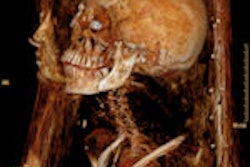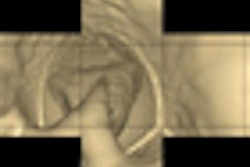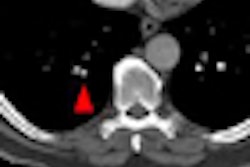There was no runaway winner among the three bowel preps used in the recently published National CT Colonography Trial (ACRIN 6664), but there were certainly differences in how they performed, according to a team from Arizona that compared the bowel preparations used in the landmark 15-center screening trial of more than 2,500 individuals.
There is no accepted standardized method of performing bowel cleansing for virtual colonoscopy (also known as CT colonography, or CTC). Several types of preparations are used depending on the patient and the preferences of the provider.
"The objective of our study was to determine if CTC performance was affected by the type of bowel prep used," said Dr. Mark Kuo from Scottsdale Medical Imaging in Scottsdale, AZ.
Three main cathartic preparations were used in the study: polyethylene glycol (PEG), sodium phosphate (SP), and magnesium citrate (MC).
For stool tagging, 15 g of a barium sulfate suspension was administered to each patient the day before the exam, to be ingested in 5 g doses with breakfast, lunch, and dinner. For fluid tagging, the subjects ingested 5 cc of water-soluble oral contrast material the night before and the morning of the exam. Patients were also given 10 mg bisacodyl laxative tablets.
"The type of bowel prep used by each participant was dependent on the institution, and in particular usually the gastroenterologist, so if the gastroenterologist preferred that patients use Phospho-soda then that was the prep used for each patient," Kuo said at the 2008 RSNA meeting.
The study team examined prep utilization, patient compliance, and residual stool and fluid scores. "Perhaps most important, we wanted to look at the sensitivity and specificity of each bowel prep as it related to detecting polyps," Kuo said.
All readers completed a questionnaire that graded the amount of stool and fluid present in each segment on a four-point scale. A score of 1 meant none; 2 was minimal; 3, moderate; and 4, nondiagnostic.
Segmentally unblinded same-day optical colonoscopy, which served as the reference standard for the study, was performed immediately after prone and supine virtual colonoscopy scans.
In all, 2,531 CTC exams were performed at 15 institutions. Of these, 1,020 exams used PEG, 1,403 used SP, 102 used MC, and six patients used other preps. All but 24 patients used 10 mg bisacodyl tablets.
The researchers looked at patients who had moderate or higher scores (3 or 4) for residual fluid or stool in any segment; residual fluid was more common than residual stool, Kuo said.
The median residual fluid score was 2 for PEG, 2 for SP, and 3 for MC. MC had the highest number of patients with moderate or high fluid scores at 63% and was significantly more likely to leave fluid compared to PEG or SP (p = 0.01).
The median score for residual stool was 2 for PEG, SP, and MC. However, SP did the best at clearing residual stool. Just 10% of SP patients had segments rated 3 or 4 for residual stool, versus 16% for MC and 17% for PEG, Kuo said. SP left significantly less stool than PEG or MC (p < 0.001).
An important limitation of the study was the low utilization of MC in only 102 patients and primarily at a single facility, Kuo said. In contrast, SP was used in all centers and by all 15 readers, and PEG was evaluated by 13 of the 15 readers.
The effect of fluid and stool cleansing was not associated with sensitivity for polyp detection, but specificity did decrease as stool scores increased, he said. The average sensitivity and specificity for patients with polyps 10 mm or larger was 86% and 86% for PEG, 85% and 88% for SP, and 100% and 61% for MC, with no statistically significant difference in sensitivity among the preparations.
PEG had the lowest compliance at 93% of subjects, MC had the worst fluid clearance, and SP had the best stool clearance among all the preps used in the study.
"We basically showed that there's no significant difference in sensitivity and specificity between Phospho-soda, MC, and the PEG preps," Kuo said.
By Eric Barnes
AuntMinnie.com staff writer
February 9, 2009
Related Reading
Need for VC colon screening trumps physician turf battles, January 20, 2009
Same-day VC prep works, but some preps are better than others, December 16, 2008
Dual-energy VC makes tagged materials disappear, October 29, 2008
ACRIN virtual colonoscopy training tied to performance, October 27, 2008
ACRIN trial shows VC's accuracy comparable to optical colonoscopy, September 18, 2008
Copyright © 2009 AuntMinnie.com



















